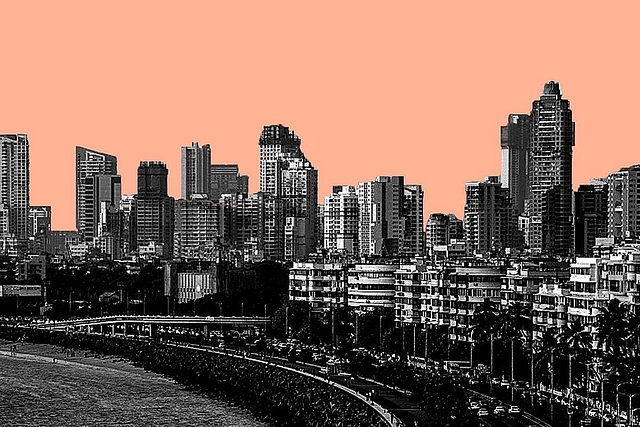
A Lockdown Changed Mumbai From An Industrial To A Commercial City. What Will This One Lead To?
As the state of Maharashtra completes 60 years of existence in its current form, its capital Mumbai stands at the crossroads.
Mumbai was once an industrial city – a fact relatable today, only because of the several areas in the old island city named after the mills which once stood there.
Only in the last four decades, the city shifted from being a thriving industrial centre to becoming India’s commercial capital. This shift came about after the failure of the 1982 labour strike.
Mumbai has always been the city of dreams. But in the industrial era, these dreams were humbler by today’s standards. India’s main textile centre, the city provided employment to hundreds of thousands of people from across Maharashtra.
It was a lockdown – willingly enforced by more than two hundred and fifty thousand workers for over a year – which totally changed the way Mumbai evolved.
This lockdown was led by Datta Samant, a prominent trade union leader of his era. The mill workers demanded higher wages and better working conditions. Samant had risen to fame after cutting a higher wage deal with PAL – then India’s leading passenger car company.
The Mumbai mill workers chose him to lead their agitation. A doctor by profession, he chose to be a part of labour politics as his parents came from a working class background.
Trade unionism was not new to Mumbai.
George Fernandez had earned his political stripes as a labour leader in 1960s. After his active political shift when he became a Member of Parliament in 1967, Mumbai did not have many strong labour leaders for a few years.
The Indian National Trade Union Congress (INTUC) became the sole face of trade unionism, to which the Rashtriya Mill Mazdoor Sangh (RMMS) was also affiliated.
INTUC was the trade union wing of Congress and wasn’t the best voice for labourers in the politically tumultuous 1970s. This was also the decade where the owner-worker conflicts peaked, aptly characterised by Bollywood and the rise of the angry young man Amitabh Bachchan.
Samant was also an INTUC leader but he was jailed during the Emergency as he was recognised as an influential and combative voice.
After the Emergency, Samant became the key labour voice and in 1981, the Mumbai mill workers entrusted him with the responsibility of negotiating on their behalf. Although his idea was to use a short strike as pressure tactic, neither the mill owners nor the Maharashtra government gave in to the demands.
The strike became a full lockdown and continued for a year.
With Mumbai paralysed, its economic and political characteristics started to change. Several industrial units moved outside Mumbai in the Thane region, and many others to Gujarat. Thousands of workers were rendered jobless.
The mill owners diversified into real estate development, thus paving way for building some of India’s swankiest residential as well as commercial properties in South Mumbai.
The angst of the working class but unemployed Maharashtrian population was tapped very effectively by Shiv Sena under the leadership of Bal Thackeray. The party quickly rose to be a force in the city and won the local municipal poll in 1985, continuing to run the Brihanmumbai Municipal Corporation (BMC) till date.
Samant lost his grip over labour politics in the city with his strike seen as a broad failure. Although the Left parties have never accepted that the strike failed, their general influence over the city’s politics diminished soon after.
Samant did win the Bombay South Central Lok Sabha constituency in 1984, contesting as an Independent candidate. Mumbai South Central later evolved as Shiv Sena stronghold. Samant was murdered in 1997, toward the fag end of Mumbai’s violent, bloody gang wars.
Although Mumbai moved on, the plight of the working class in the city has again come to the fore in the midst of another national lockdown.
This time, the lockdown has been imposed by the government to prevent the spread of coronavirus.
Unfortunately, given the living conditions in the old island city, this lockdown also has not been very effective as Mumbai has the highest number of positive cases for a single city.
Today, there are talks about supply chain rebalancing and relocation of manufacturing facilities globally to create more business and operational redundancies.
Mumbai has already witnessed this rebalancing during the 1981-82 lockdown. The city is India’s commercial capital, bustling with services industry in several sectors and driving the Indian economy – both in terms of numbers and in terms of policy influence.
Can Mumbai use this lockdown to change its fundamental urban planning issues?
Crisis usually creates its own opportunities, and the urban planners in Mumbai have now been presented with one such opportunity.
Moving away from the romanticism of living conditions, which are perhaps a century behind most big global cities, and planning urbanisation, which allows for social distancing when the need arises, should be the goal.
Unfortunately, the political as well as resource constraints don’t make this task any easier.
As the state of Maharashtra completes 60 years of existence in its current form, its capital Mumbai stands at the crossroads.
The coronavirus pandemic will no doubt be subsumed by the ‘Mumbai Spirit’ sooner than later like all other problems which attack the city. But can this time, the city and its residents find more institutional solutions to their civic issues, not just the ones driven by human enterprise?